Due to King Louis Xivs Role in the Arts Dancing Became Accepted as a Professional Career Choice

Ballet (French: [balɛ]) is a type of performance trip the light fantastic that originated during the Italian Renaissance in the fifteenth century and later adult into a concert dance grade in France and Russian federation. Information technology has since become a widespread and highly technical class of dance with its ain vocabulary. Ballet has been influential globally and has defined the foundational techniques which are used in many other dance genres and cultures. Various schools around the world have incorporated their own cultures. Every bit a result, ballet has evolved in distinct ways.
A ballet equally a unified work comprises the choreography and music for a ballet production. Ballets are choreographed and performed past trained ballet dancers. Traditional classical ballets are unremarkably performed with classical music accessory and using elaborate costumes and staging, whereas modern ballets are often performed in unproblematic costumes and without elaborate sets or scenery.
Etymology
Ballet is a French discussion which had its origin in Italian balletto, a diminutive of ballo (dance) which comes from Latin ballo, ballare, meaning "to dance",[i] [ii] which in turn comes from the Greek "βαλλίζω" (ballizo), "to dance, to jump nearly".[2] [iii] The word came into English language usage from the French effectually 1630.
History
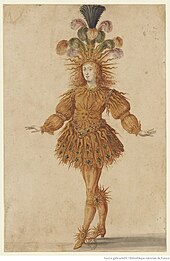
Ballet originated in the Italian Renaissance courts of the fifteenth and sixteenth centuries. Nether Catherine de' Medici'southward influence as Queen, it spread to France, where it developed even further.[4] The dancers in these early courtroom ballets were mostly noble amateurs. Ornamented costumes were meant to impress viewers, but they restricted performers' freedom of movement.[five]
The ballets were performed in large chambers with viewers on 3 sides. The implementation of the proscenium curvation from 1618 on distanced performers from audience members, who could then better view and appreciate the technical feats of the professional dancers in the productions.[ citation needed ]
French court ballet reached its height under the reign of King Louis XIV. Louis founded the Académie Royale de Danse (Regal Dance Academy) in 1661 to plant standards and certify dance instructors.[6] In 1672, Louis XIV made Jean-Baptiste Lully the director of the Académie Royale de Musique (Paris Opera) from which the start professional person ballet company, the Paris Opera Ballet, arose.[7] Pierre Beauchamp served equally Lully's ballet-master. Together their partnership would drastically influence the development of ballet, as evidenced by the credit given to them for the cosmos of the five major positions of the anxiety. By 1681, the first "ballerinas" took the stage post-obit years of training at the Académie.[5]
Ballet started to decline in France after 1830, but it continued to develop in Denmark, Italy, and Russian federation. The inflow in Europe of the Ballets Russes led past Sergei Diaghilev on the eve of the First World War revived interest in the ballet and started the modern era.[eight]
In the twentieth century, ballet had a wide influence on other trip the light fantastic toe genres,[nine] Too in the twentieth century, ballet took a plow dividing it from classical ballet to the introduction of modernistic dance, leading to modernist movements in several countries.[10]
Famous dancers of the twentieth century include Anna Pavlova, Galina Ulanova, Rudolf Nureyev, Maya Plisetskaya, Margot Fonteyn, Rosella Hightower, Maria Tall Chief, Erik Bruhn, Mikhail Baryshnikov, Suzanne Farrell, Gelsey Kirkland, Natalia Makarova, Arthur Mitchell, and Jeanne Devereaux.[11] Jeanne Devereaux performed as a prima ballerina for three decades and set up a globe's record past being able to execute 16 triple fouettes.[12]
Styles

Stylistic variations and subgenres take evolved over time. Early, classical variations are primarily associated with geographic origin. Examples of this are Russian ballet, French ballet, and Italian ballet. Later variations, such as contemporary ballet and neoclassical ballet, comprise both classical ballet and not-traditional technique and motion. Perhaps the about widely known and performed ballet mode is tardily Romantic ballet (or Ballet blanc).
Classical ballet
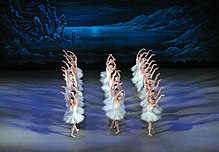
The Valse des cygnes from Deed 2 of the Ivanov/Petipa edition of Swan Lake
Classical ballet is based on traditional ballet technique and vocabulary.[13] Dissimilar styles have emerged in dissimilar countries, such as French ballet, Italian ballet, English language ballet, and Russian ballet. Several of the classical ballet styles are associated with specific training methods, typically named later their creators (come across below). The Royal Academy of Trip the light fantastic method is a ballet technique and training system that was founded by a diverse group of ballet dancers. They merged their respective trip the light fantastic toe methods (Italian, French, Danish and Russian) to create a new manner of ballet that is unique to the arrangement and is recognized internationally every bit the English fashion of ballet.[8] Some examples of classical ballet productions are: Swan Lake, The Sleeping Dazzler and The Nutcracker.
Romantic ballet

Romantic ballet was an creative move of classical ballet and several productions remain in the classical repertoire today. The Romantic era was marked by the emergence of pointe piece of work, the dominance of female dancers, and longer, flowy tutus that effort to exemplify softness and a frail aura.[5] This motion occurred during the early to mid-nineteenth century (the Romantic era) and featured themes that emphasized intense emotion equally a source of aesthetic experience. The plots of many romantic ballets revolved around spirit women (sylphs, wilis, and ghosts) who enslaved the hearts and senses of mortal men. The 1827 ballet La Sylphide is widely considered to be the first, and the 1870 ballet Coppélia is considered to be the last.[four] Famous ballet dancers of the Romantic era include Marie Taglioni, Fanny Elssler, and Jules Perrot. Jules Perrot is also known for his choreography, especially that of Giselle, frequently considered to be the well-nigh widely celebrated romantic ballet.[v]
Neoclassical ballet
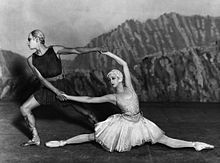
Neoclassical ballet is usually abstract, with no articulate plot, costumes or scenery. Music choice can be various and volition frequently include music that is also neoclassical (east.g. Stravinsky, Roussel). Tim Scholl, author of From Petipa to Balanchine, considers George Balanchine's Apollo in 1928 to be the beginning neoclassical ballet. Apollo represented a return to class in response to Sergei Diaghilev's abstract ballets. Balanchine worked with modern trip the light fantastic choreographer Martha Graham, and brought modern dancers into his company such equally Paul Taylor, who in 1959 performed in Balanchine's Episodes.[xiv]
While Balanchine is widely considered the face of neoclassical ballet, there were others who made significant contributions. Frederick Ashton'southward Symphonic Variations (1946) is a seminal work for the choreographer. Set to César Franck's score of the same championship, it is a pure-dance interpretation of the score.[v]
Another form, Modern Ballet, also emerged as an offshoot of neoclassicism. Amongst the innovators in this grade were Glen Tetley, Robert Joffrey and Gerald Arpino. While difficult to parse modern ballet from neoclassicism, the work of these choreographers favored a greater athleticism that departed from the delicacy of ballet. The physicality was more than daring, with mood, bailiwick matter and music more than intense. An example of this would be Joffrey's Astarte (1967), which featured a rock score and sexual overtones in the choreography.[eight]
Contemporary ballet

A ballet jump performed with modern, not-classical course in a contemporary ballet
This ballet style is frequently performed barefoot. Contemporary ballets may include mime and acting, and are unremarkably ready to music (typically orchestral just occasionally vocal). Information technology can be difficult to differentiate this class from neoclassical or modern ballet. Contemporary ballet is likewise close to gimmicky trip the light fantastic because many contemporary ballet concepts come from the ideas and innovations of twentieth-century modern dance, including floor work and turn-in of the legs. The main distinction is that ballet technique is essential to perform a contemporary ballet.
George Balanchine is considered to accept been a pioneer of contemporary ballet. Another early gimmicky ballet choreographer, Twyla Tharp, choreographed Push Comes To Shove for the American Ballet Theatre in 1976, and in 1986 created In The Upper Room for her own company. Both of these pieces were considered innovative for their melding of distinctly modern movements with the use of pointe shoes and classically trained dancers.
Today there are many contemporary ballet companies and choreographers. These include Alonzo Male monarch and his company LINES Ballet; Matthew Bourne and his company New Adventures; Complexions Contemporary Ballet; Nacho Duato and his Compañia Nacional de Danza; William Forsythe and The Forsythe Company; and Jiří Kylián of the Nederlands Dans Theater. Traditionally "classical" companies, such as the Mariinsky (Kirov) Ballet and the Paris Opera Ballet, besides regularly perform contemporary works.
The term ballet has evolved to include all forms associated with information technology. Someone training as a ballet dancer will now be expected to perform neoclassical, mod and contemporary work. A ballet dancer is expected to be able to exist stately and regal for classical piece of work, free and lyrical in neoclassical work, and unassuming, harsh or pedestrian for modern and contemporary work. In improver, there are several modern varieties of dance that fuse classical ballet technique with contemporary trip the light fantastic toe, such as Hiplet, that require dancers to be practised in non-Western dance styles.[15]
Technical methods of ballet instruction
There are 6 widely used, internationally recognized methods to teach or written report ballet. These methods are the French Schoolhouse, the Vaganova Method, the Cecchetti Method, the Bournonville method, the Royal Academy of Trip the light fantastic toe method (English style), and the Balanchine method (American mode). Many more schools of technique be in diverse countries.
Although preschool-age children are a lucrative source of income for a ballet studio, ballet didactics is by and large not advisable for young children.[16] [ failed verification ] Initial didactics requires standing nonetheless and concentrating on posture, rather than dancing. Because of this, many ballet programs accept historically not accepted students until approximately historic period viii. Creative movement and non-demanding pre-ballet classes are recommended every bit alternatives for children.[17] [18]
French method

The French method is the basis of all ballet training. When Louis 14 created the Académie Royale de Danse in 1661, he helped to create the codified technique nevertheless used today by those in the profession, regardless of what method of training they adhere to. The French school was particularly revitalized under Rudolf Nureyev, in the 1980s. His influence revitalized and renewed appreciation for this fashion, and has drastically shaped ballet as a whole.[19] In fact, the French schoolhouse is now sometimes referred to as Nureyev schoolhouse. The French method is oftentimes characterized by technical precision, fluidity and gracefulness, and elegant, clean lines. For this way, fast footwork is often utilized in order to give the impression that the performers are drifting lightly across the stage.[20] Two important trademarks of this technique are the specific way in which the port de bras and the épaulement are performed, more rounded than when dancing in a Russian style, only not as rounded as the Danish mode.[21]
Vaganova method
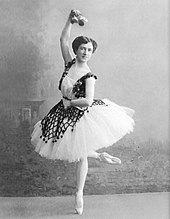
Agrippina Vaganova, "Esmeralda" 1910
The Vaganova method is a style of ballet preparation that emerged from Russian ballet, created by Agrippina Vaganova. After retiring from dance in 1916, Vaganova turned to teaching at the St. petersburg Choreographic Schoolhouse in 1921. Her preparation method is at present internationally recognized and her volume, The Fundamentals of Classical Dance (1934), is a classic reference. This method is marked past the fusion of the classical French mode, specifically elements from the Romantic era, with the athleticism of the Italian method, and the soulful passion of Russian ballet.[twenty] She developed an extremely precise method of educational activity in her book Basic Principles of Russian Classical dance (1948). This includes outlining when to teach technical components to students in their ballet careers, for how long to focus on it, and the right corporeality of focus at each stage of the student'south career. These textbooks go along to be extremely important to the instruction of ballet today.
The method emphasizes development of forcefulness, flexibility, and endurance for the proper performance of ballet. She espoused the belief that equal importance should be placed on the arms and legs while performing ballet, as this will bring harmony and greater expression to the body as a whole.[22]
Cecchetti method

Enrico Cecchetti with Anna Pavlova
Developed past Enrico Cecchetti (1850-1928), this method is one known internationally for its intense reliance of the agreement of beefcake as it relates to classical ballet. The goal of this method is to instill important characteristics for the performance of ballet into students so that they do not demand to rely on imitations of teachers. Of import components for this method is the emphasis of residual, elevations, ballon, poise, and force.
This method espouses the importance of recognizing that all parts of the body move together to create beautiful, graceful lines, and as such cautions against thinking of ballet in terms of the artillery, legs, and neck and torso equally carve up parts. This method is well known for eight port de bras that are utilized.[20]
Bournonville method
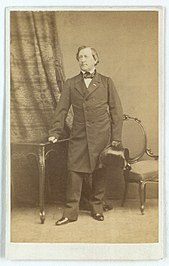
The Bournonville method is a Danish method first devised by August Bournonville. Bournonville was heavily influenced by the early French ballet method due to his preparation with his male parent, Antoine Bournonville and other important French ballet masters. This method has many fashion differences that differentiate information technology from other ballet methods taught today.[23] A key component is the use of diagonal épaulements, with the upper body turning towards the working foot typically. This method likewise incorporates very bones use of artillery, pirouettes from a low développé position into seconde, and use of fifth position bras en bas for the first and end of movements.
The Bournonville method produces dancers who take cute ballon ("the illusion of imponderable lightness"[24]).
The Royal University of Dance method (RAD)

Young girls competing at the Purple University of Dancing (London) exams held in Brisbane and Toowoomba, 1938
The Regal Academy of Dance method, also referred to as the English style of ballet, was established in 1920 by Genee, Karsavina, Bedells, E Espinosa, and Richardson. The goal of this method is to promote bookish training in classical ballet throughout Great Uk. This style also spread to the United states of america, and is widely utilized still today. There are specific grade levels which a pupil must move through in social club to complete training in this method.[25] The key principle behind this method of instruction is that bones ballet technique must be taught at a slow stride, with difficulty progression ofttimes much slower than the rest of the methods. The idea behind this is if a educatee is to put in a large corporeality of effort into perfecting the basic steps, the technique learned in these steps allow a student to utilize harder ones at a much easier rate.[20]
Balanchine method
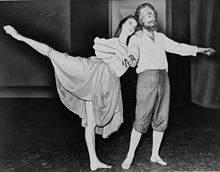
Developed by George Balanchine at the New York City Ballet. His method draws heavily on his own preparation every bit a dancer in Russian federation. The technique is known for extreme speed throughout routines, emphasis on lines, and deep pliés. Perhaps i of the almost well known differences of this style is the unorthodox positioning of the body.[20] Dancers of this style frequently have flexed hands and even feet, and are placed in off-balance positions. Important ballet studios pedagogy this method are the Miami City Ballet, Ballet Chicago Studio visitor, and the School of American Ballet in New York.[26]
Costumes

Anna Pavlova (prima ballerina); Early materials for ballet costumes were heavy, hindering the dancer's movements
Ballet costumes play an of import part in the ballet community. They are oft the only survival of a product, representing a living imaginary film of the scene.[27]
Renaissance and Baroque
The roots of ballet become back to the Renaissance in France and Italia when court wear was the beginning of ballet costumes. Ballet costumes have been around since the early fifteenth century. Cotton and silk were mixed with flax, woven into semitransparent gauze[27] to create exquisite ballet costumes.
Seventeenth century
During the seventeenth century, different types of fabrics and designs were used to brand costumes more spectacular and eye catching. Court apparel still remained for women during this century. Silks, satins and fabrics embroidered with real gold and precious stones increased the level of spectacular decoration associated with ballet costumes.[27] Women's costumes also consisted of heavy garments and genu-long skirts which made it hard for them to create much move and gesture.
Eighteenth century
During the eighteenth century, stage costumes were notwithstanding very similar to court wear but progressed over time, mostly due to the French dancer and ballet-chief Jean-Georges Noverre (1727–1810) whose proposals to modernize ballet are independent in his revolutionary Lettres sur la danse et les ballets (1760). Noverre's book contradistinct the emphasis in a production abroad from the costumes towards the concrete movements and emotions of the dancers.
European ballet was centered in the Paris Opera.[27] During this era, skirts were raised a few inches off the ground. Flowers, flounces, ribbons, and lace emphasized this opulent feminine style, as soft pastel tones in citron, peach, pinkish and pistachio dominated the color range.[27]
Nineteenth century

Olga Spessiva; Swan Lake Costume in the twentieth century
During the early on nineteenth century, close-fitting body costumes, floral crowns, corsages and jewels were used. Ideals of Romanticism were reflected through female person movements.[27]
Costumes became much tighter as corsets started to come into use, to show off the curves on a ballerina. Jewels and bedazzled costumes became much more popular.
Twentieth century

During the twentieth century, ballet costumes transitioned back to the influence of Russian ballet. Ballerina skirts became knee-length tutus, afterward on in order to prove off their precise pointe work. Colors used on stage costumes likewise became much more than vibrant. Designers used colors such as cherry-red, orange, yellow, etc. to create visual expression when ballet dancers perform on stage.
Ballet as a career
Professional person dancers are generally not well paid, and earn less money than a typical worker.[28] As of 2020, American dancers (including ballet and other dance forms) were paid an boilerplate of Us$19 per hour, with pay somewhat better for teachers than for performers.[28]
The job outlook is not strong, and the competition to become a chore is intense, with the number of applicants vastly exceeding the number of job openings.[28] Virtually jobs involve pedagogy in private dance schools.[28]
Choreographers are paid improve than dancers.[28] Musicians and singers are paid better per hour than either dancers or choreographers, nearly Usa$30 per hr; however, total-time piece of work is unusual for musicians.[29]
Health effects
Teenage daughter ballet dancers are prone to stress fractures in the showtime rib.[30] Eating disorders are a common stereotype associated with ballet.[ citation needed ] In improver, some researchers take noted that intensive training in ballet results in lower bone mineral density in the arms.[31]
Criticism
Near ballet choreography is written then that it tin can simply exist performed by a relatively immature dancer.[32] The structure of ballet – in which a (unremarkably) male choreographer or director uses (by and large) women's bodies to express his creative vision, while ignoring, objectifying, or silencing the women involved[ clarification needed ] – has been criticized as harming women.[32] [33]
See besides
- Ballet glossary
- Ballet Dancer
- Ballet-related lists
- Trip the light fantastic and wellness
- List of ballets by title
- Western stereotype of the male ballet dancer
- Ballet pointe shoe
References
- ^ Chantrell, Glynnis (2002). The Oxford Essential Dictionary of Word Histories. New York: Berkley Books. ISBN978-0-425-19098-2.
- ^ a b Liddell, Henry George; Scott, Robert. "A Greek-English Dictionary". Perseus Digital Library. Archived from the original on 2011-06-29.
- ^ Harper, Douglas. "Online Etymology Dictionary". Archived from the original on 2014-04-xiii.
- ^ a b Homans, Jennifer (2010). Apollo'southward Angels: A History of Ballet . New York: Random Firm. pp. 1–four. ISBN978-1-4000-6060-3.
- ^ a b c d e Clarke, Mary; Crisp, Clement (1992). Ballet: An Illustrated History. U.k.: Hamish Hamilton. pp. 17–19. ISBN978-0-241-13068-1.
- ^ "The Fine art of Power: How Louis XIV Ruled France ... With Ballet". Mental floss. 2017-03-15. Archived from the original on 2017-10-02. Retrieved 2017-10-02 .
- ^ Craine, Deborah; MacKrell, Judith (2000). The Oxford Dictionary of Trip the light fantastic. Oxford University Press. p. 2. ISBN978-0-19-860106-vii.
It is from this institution that French ballet has evolved rather than the Académie Royale de Danse.
- ^ a b c Greskovic, Robert (1998). Ballet 101: A Complete Guide to Learning and Loving the Ballet. New York, New York: Hyperion Books. pp. 46–57. ISBN978-0-7868-8155-0.
- ^ "Ballet And Modern Dance: Using Ballet As The Basis For Other Trip the light fantastic toe Techniques". Student Resources. 2014-08-05. Archived from the original on 2017-10-02. Retrieved 2017-07-26 .
- ^ Wulff, Helena (1998). Ballet Across Borders: Career and Culture in the World of Dancers. Oxford: Berg publishers. p. 44. ISBN978-1-85973-998-3.
- ^ "The 10 greatest ballet dancers of the twentieth century". Classic FM. Archived from the original on 2017-10-02. Retrieved 2017-10-02 .
- ^ Lesko, Kathleen Menzie. Jeannne Devereaux, Prima Ballerina of Vaudeville and Broadway, pp. iii, 28-ix, McFarland & Company, Inc., Jefferson, North Carolina, 2017, ISBN 978-1-4766-6694-5.
- ^ Grant, Gail (1982). Technical Manual and Dictionary of Classical Ballet. New York, U.s.a.: Dover Publications. ISBN978-0-486-21843-4.
- ^ Scholl, Tim (1994). From Petipa to Balanchine: Classical Revival and the Modernization of Ballet. London: Routledge. ISBN978-0415756211.
- ^ Kourlas, Gia (2016-09-02). "Hiplet: An Implausible Hybrid Plants Itself on Pointe". The New York Times. ISSN 0362-4331. Archived from the original on 2016-12-21. Retrieved 2016-12-03 .
- ^ Kaufman, Sarah Fifty. Kaufman (10 October 2019). "Parents, yous're enrolling your lilliputian ones in the wrong kind of dance class". The Washington Post.
- ^ Paskevska, Anna (1997-10-20). Getting Started in Ballet : A Parent's Guide to Trip the light fantastic toe Didactics: A Parent's Guide to Dance Education . Oxford University Printing, USA. pp. 30. ISBN978-0-xix-802773-7.
- ^ Medova, Marie-Laure (2004). Ballet for Beginners. Sterling Publishing Company, Inc. p. eleven. ISBN978-1-4027-1715-4.
- ^ "Ballet Methods: What Are They? | TutuTix". TutuTix. 2016-05-09. Archived from the original on 2017-11-xi. Retrieved 2017-07-26 .
- ^ a b c d e "Different Ballet Methods". world wide web.ottawaballetschool.com. Archived from the original on 2017-07-eleven. Retrieved 2017-07-26 .
- ^ "The Paris Opéra Ballet Schoolhouse". Dance Spirit. 2010-01-01. Archived from the original on 2017-11-11. Retrieved 2017-07-26 .
- ^ "Vaganova Method" (in Russian). International Ballet Theater Academy ibtacademy.org. Archived from the original on 2017-xi-11. Retrieved 2017-07-26 .
- ^ "Bournonville.com". www.bournonville.com. Archived from the original on 2017-10-27. Retrieved 2017-07-26 .
- ^ "Bournonville: The Danish Manner of Dancing - Ballet Position". Ballet Position. 2016-06-17. Archived from the original on 2018-09-10. Retrieved 2018-09-11 .
- ^ "Ballet Training Techniques - The Royal Academy of Trip the light fantastic toe (RAD) - DANCE Hamlet - dance portal and online community". www.dancevillage.com. Archived from the original on 2016-02-27. Retrieved 2017-07-26 .
- ^ "History of Ballet Dance - Trip the light fantastic History Articles". dancelessons.internet. Archived from the original on 2017-02-22. Retrieved 2017-07-26 .
- ^ a b c d e f "Ballet Costume History - Tutu Étoile". Tutu Étoile. Archived from the original on 2016-11-14. Retrieved 2016-11-xviii .
- ^ a b c d due east "Dancers and Choreographers: Occupational Outlook Handbook". U.Due south. Bureau of Labor Statistics. viii September 2021. Archived from the original on 2012-04-03. Retrieved 2022-01-20 .
- ^ "Musicians and Singers: Occupational Outlook Handbook". U.S. Bureau of Labor Statistics. 8 September 2021. Retrieved 2022-01-20 .
- ^ Kiel, John; Kaiser, Kimberly (2018), "Stress Reaction and Fractures", StatPearls, StatPearls Publishing, PMID 29939612, retrieved 2018-11-05
- ^ Wewege, Michael A.; Ward, Rachel Eastward. (August 2018). "Bone mineral density in pre-professional female person ballet dancers: A systematic review and meta-analysis". Journal of Science and Medicine in Sport. 21 (viii): 783–788. doi:10.1016/j.jsams.2018.02.006. ISSN 1878-1861. PMID 29526411.
- ^ a b O'Connell Whittet, Ellen (xi Oct 2018). "Is At that place Such A Thing As Ballet That Doesn't Injure Women?". BuzzFeed News. Archived from the original on 5 November 2018. Retrieved 2018-11-05 .
- ^ Fisher, Jennifer (2007). "Tulle as Tool: Embracing the Conflict of the Ballerina equally Powerhouse". Trip the light fantastic Enquiry Periodical. 39 (1): two–24. doi:ten.1017/S0149767700000048. JSTOR 20444681. S2CID 194065932.
Further reading
- Anderson, Jack (1992). Ballet & Modern Dance: A Curtailed History (2nd ed.). Princeton, NJ: Princeton Volume Company, Publishers. ISBN978-0-87127-172-3.
- Au, Susan (2002). Ballet & Modern Dance (2d ed.). London: Thames & Hudson world of art. ISBN978-0-500-20352-1.
- Bland, Alexander (1976). A History of Ballet and Trip the light fantastic in the Western Globe . New York: Praeger Publishers. ISBN978-0-275-53740-1.
- Darius, Adam (2007). Arabesques Through Time. Helsinki: Harlequinade Books. ISBN 951-98232-4-seven
- Gordon, Suzanne (1984). Off Residual: The Existent Globe of Ballet. McGraw-Colina. ISBN978-0-07-023770-4.
- Kant, Marion (2007). Cambridge Companion to Ballet. Cambridge Companions to Music (1st ed.). Cambridge, Great britain: Cambridge Academy Press, Publishers. ISBN978-0-521-53986-nine.
- Kirstein, Lincoln; Stuart, Muriel (1952). The Archetype Ballet . New York: Alfred A Knopf.
- Lee, Carol (2002). Ballet In Western Civilization: A History of its Origins and Development. New York: Routledge. ISBN978-0-415-94256-0.
External links
| | Wikimedia Commons has media related to Ballet. |
| | Wait upwardly ballet in Wiktionary, the gratuitous lexicon. |
- Chisholm, Hugh, ed. (1911). . Encyclopædia Britannica (11th ed.). Cambridge Academy Press.
Source: https://en.wikipedia.org/wiki/Ballet_dance
0 Response to "Due to King Louis Xivs Role in the Arts Dancing Became Accepted as a Professional Career Choice"
ارسال یک نظر